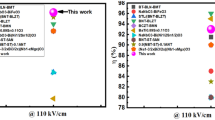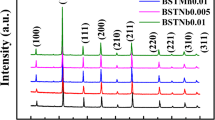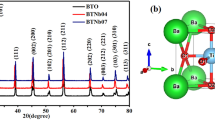Abstract
Electrocaloric (EC) refrigeration holds the promise to achieve next-generation refrigeration technology that can be efficiently powered by electricity. BaTiO3 (BT)-based ferroelectric materials are attractive owing to their environmentally benign compositions, large polarization, and existing manufacturing method for multilayer ceramic capacitors (MLCC), which have stimulated intensive research efforts on these materials. Here, we report an enhanced electrocaloric effect (ECE) and the refrigeration capacity of multi-element B-site substituted BT-based ceramics. The compositions of the proposed Ba(HfxSnxZry)-Ti1−2x−yO3 (BHSZT) ceramics were selected by fine-tuning each substituent against Titanium ions Ti4+, aiming to their respective morphotropic phase boundary (MPB). The BHSZT exhibited an ECE that is greater than that of the single-element substituted BaTiO3 ceramics by at least 50%, reaching an adiabatic temperature change of above 1.7 K under 40 kV/cm. Meanwhile, the operating temperature window of the BHSZT ceramics is observed to cover the room temperature, which is a critical feature that allows the device implementation in our daily life. The multi-element substitution improved the overall ECE performances, providing a high degree of freedom for polar reorientation and hence the large polar entropy that could be utilized by the external electric field.
Similar content being viewed by others
References
Qian S, Nasuta D, Rhoads A, et al. Not-in-kind cooling technologies: A quantitative comparison of refrigerants and system performance. Int J Refriger, 2016, 62: 177–192
Atanasiu B, Bertoldi P. Latest assessment of residential electricity consumption and efficiency trends in the European Union. Int J Green Energy, 2010, 7: 552–575
Shi J, Han D, Li Z, et al. Electrocaloric cooling materials and devices for zero-global-warming-potential, high-efficiency refrigeration. Joule, 2019, 3: 1200–1225
Defay E, Faye R, Despesse G, et al. Enhanced electrocaloric efficiency via energy recovery. Nat Commun, 2018, 9: 1827
Moya X, Defay E, Heine V, et al. Too cool to work. Nat Phys, 2015, 11: 202–205
Neese B, Chu B, Lu S G, et al. Large electrocaloric effect in ferroelectric polymers near room temperature. Science, 2008, 321: 821–823
Ma R, Zhang Z, Tong K, et al. Highly efficient electrocaloric cooling with electrostatic actuation. Science, 2017, 357: 1130–1134
Moya X, Kar-Narayan S, Mathur N D. Caloric materials near ferroic phase transitions. Nat Mater, 2014, 13: 439–450
Gu H, Qian X, Li X, et al. A chip scale electrocaloric effect based cooling device. Appl Phys Lett, 2013, 102: 122904
Torelló A, Lheritier P, Usui T, et al. Giant temperature span in electrocaloric regenerator. Science, 2020, 370: 125–129
Wang Y, Zhang Z, Usui T, et al. A high-performance solid-state electrocaloric cooling system. Science, 2020, 370: 129–133
Meng Y, Zhang Z, Wu H, et al. A cascade electrocaloric cooling device for large temperature lift. Nat Energy, 2020, 5: 996–1002
Zhang T, Qian X S, Gu H, et al. An electrocaloric refrigerator with direct solid to solid regeneration. Appl Phys Lett, 2017, 110: 243503
Lu S G, Zhang Q. Electrocaloric materials for solid-state refrigeration. Adv Mater, 2009, 21: 1983–1987
Valant M. Electrocaloric materials for future solid-state refrigeration technologies. Prog Mater Sci, 2012, 57: 980–1009
Qian X, Han D, Zheng L, et al. High-entropy polymer produces a giant electrocaloric effect at low fields. Nature, 2021, 600: 664–669
Yin R, Li J, Su X, et al. Emergent enhanced electrocaloric effect within wide temperature span in laminated composite ceramics. Adv Funct Mater, 2022, 32: 2108182
Zhao C, Yang J, Huang Y, et al. Broad-temperature-span and large electrocaloric effect in lead-free ceramics utilizing successive and metastable phase transitions. J Mater Chem A, 2019, 7: 25526–25536
Nair B, Usui T, Crossley S, et al. Large electrocaloric effects in oxide multilayer capacitors over a wide temperature range. Nature, 2019, 575: 468–472
Li X, Qian X, Lu S G, et al. Tunable temperature dependence of electrocaloric effect in ferroelectric relaxor poly(vinylidene fluoride-trifluoroethylene-chlorofluoroethylene terpolymer. Appl Phys Lett, 2011, 99: 052907
Moya X, Mathur N D. Double bond with a licence to chill. Joule, 2022, 6: 289–290
Nouchokgwe Y, Lheritier P, Hong C H, et al. Giant electrocaloric materials energy efficiency in highly ordered lead scandium tantalate. Nat Commun, 2021, 12: 3298
Mischenko A S, Zhang Q, Scott J F, et al. Giant electrocaloric effect in thin-film PbZr0.95Ti0.05O3. Science, 2006, 311: 1270–1271
Wu H H, Cohen R E. Electric-field-induced phase transition and electrocaloric effect in PMN-PT. Phys Rev B, 2017, 96: 054116
Moya X, Stern-Taulats E, Crossley S, et al. Giant electrocaloric strength in single-crystal BaTiO3. Adv Mater, 2013, 25: 1360–1365
Yang J, Zhao Y, Lou X, et al. Synergistically optimizing electrocaloric effects and temperature span in KNN-based ceramics utilizing a relaxor multiphase boundary. J Mater Chem C, 2020, 8: 4030–4039
Bai Y, Han X, Zheng X C, et al. Both high reliability and giant electrocaloric strength in BaTiO3 ceramics. Sci Rep, 2013, 3: 2895
Weyland F, Eisele T, Steiner S, et al. Long term stability of electro-caloric response in barium zirconate titanate. J Eur Ceramic Soc, 2018, 38: 551–556
Lei C, Bokov A A, Ye Z G. Ferroelectric to relaxor crossover and dielectric phase diagram in the BaTiO3-BaSnO3 system. J Appl Phys, 2007, 101: 084105
Tang X G, Chew K H, Chan H L W. Diffuse phase transition and dielectric tunability of Ba(ZryTi1−y)O3 relaxor ferroelectric ceramics. Acta Mater, 2004, 52: 5177–5183
Qian X S, Ye H J, Zhang Y T, et al. Giant electrocaloric response over a broad temperature range in modified BaTiO3 ceramics. Adv Funct Mater, 2014, 24: 1300–1305
Wang X, Wu J, Dkhil B, et al. Large electrocaloric strength and broad electrocaloric temperature span in lead-free Ba0.85Ca0.15Ti1−xHfxO3 ceramics. RSC Adv, 2017, 7: 5813–5820
Bai Y, Han X, Ding K, et al. Combined effects of diffuse phase transition and microstructure on the electrocaloric effect in Ba1−xSrxTiO3 ceramics. Appl Phys Lett, 2013, 103: 162902
Niu X, Jian X, Chen X, et al. Enhanced electrocaloric effect at room temperature in Mn2+ doped lead-free (BaSr)TiO3 ceramics via a direct measurement. J Adv Ceram, 2021, 10: 482–492
Upadhyay S K, Reddy V R, Bag P, et al. Electro-caloric effect in lead-free Sn doped BaTiO3 ceramics at room temperature and low applied fields. Appl Phys Lett, 2014, 105: 112907
Liu Z K, Li X, Zhang Q M. Maximizing the number of coexisting phases near invariant critical points for giant electrocaloric and electromechanical responses in ferroelectrics. Appl Phys Lett, 2012, 101: 082904
Lu S G, Rožič B, Zhang Q M, et al. Organic and inorganic relaxor ferroelectrics with giant electrocaloric effect. Appl Phys Lett, 2010, 97: 162904
Li M D, Tang X G, Zeng S M, et al. Large electrocaloric effect in lead-free Ba(HfxTiI−x)O3 ferroelectric ceramics for clean energy applications. ACS Sustain Chem Eng, 2018, 6: 8920–8925
Chen X, Shvartsman V, Lupascu D C, et al. Comment on “Giant pyroelectric energy harvesting and a negative electrocaloric effect in multilayered nanostructures” by G. Vats, A. Kumar, N. Ortega, C. R. Bowen and R. S. Katiyar, Energy Environ. Sci., 2016, 9, 1335. Energy Environ Sci, 2021, 14: 1612–1614
Han F, Bai Y, Qiao L J, et al. A systematic modification of the large electrocaloric effect within a broad temperature range in rare-earth doped BaTiO3 ceramics. J Mater Chem C, 2016, 4: 1842–1849
Wang X, Wu J, Dkhil B, et al. Enhanced electrocaloric effect near polymorphic phase boundary in lead-free potassium sodium niobate ceramics. Appl Phys Lett, 2017, 110: 063904
Kumar R, Singh S. Giant electrocaloric and energy storage performance of [(K0.5Na0.5)NbO3](1−x)-[LiSbO3]x nanocrystalline ceramics. Sci Rep, 2018, 8: 3186
Li J, Bai Y, Qin S, et al. Direct and indirect characterization of electrocaloric effect in (Na,K)NbO3 based lead-free ceramics. Appl Phys Lett, 2016, 109: 162902
Koruza J, Rožič B, Cordoyiannis G, et al. Large electrocaloric effect in lead-free K0.5Na0.5NbO3-SrTiO3 ceramics. Appl Phys Lett, 2015, 106: 202905
Yu Y, Gao F, Weyland F, et al. Significantly enhanced room temperature electrocaloric response with superior thermal stability in sodium niobate-based bulk ceramics. J Mater Chem A, 2019, 7: 11665–11672
Zhang L, Zhao C, Zheng T, et al. Large electrocaloric response with superior temperature stability in NaNbO3-based relaxor ferroelectrics benefiting from the crossover region. J Mater Chem A, 2021, 9: 2806–2814
Li F, Li K, Long M, et al. Ferroelectric-relaxor crossover induce large electrocaloric effect with ultrawide temperature span in NaNbO3-based lead-free ceramics. Appl Phys Lett, 2021, 118: 043902
Li F, Chen G, Liu X, et al. Phase-composition and temperature dependence of electrocaloric effect in lead-free Bi0.5Na0.5TiO3-BaTiO3-(Sr0.7Bi0.2□0.1)TiO3 ceramics. J Eur Ceramic Soc, 2017, 37: 4732–4740
Hagberg J, Dunce M, Birks E, et al. Electrocaloric effect in Na1/2Bi1/2TiO3-SrTiO3-PbTiO3 solid solutions. Ferroelectrics, 2012, 428: 20–26
Li F, Chen G, Liu X, et al. Type-I pseudo-first-order phase transition induced electrocaloric effect in lead-free Bi0.5Na0.5TiO3-0.06BaTiO3 ceramics. Appl Phys Lett, 2017, 110: 182904
Jiang X, Luo L, Wang B, et al. Electrocaloric effect based on the depolarization transition in (1−x)Bi0.5Na0.5TiO3−xKNbO3 lead-free ceramics. Ceramics Int, 2014, 40: 2627–2634
Peräntie J, Tailor H N, Hagberg J, et al. Electrocaloric properties in relaxor ferroelectric (1−x)Pb(Mg1/3Nb2/3)O3-xPbTiO3 system. J Appl Phys, 2013, 114: 174105
Author information
Authors and Affiliations
Corresponding author
Additional information
This work was supported by the National Key R&D Program of China (Grant No. 2020YFA0711500), the National Natural Science Foundation of China (Grant No. 52076127), and the Natural Science Foundation of Shanghai (Grant Nos. 20ZR1471700, 22JC1401800). QIAN XiaoShi was supported by the State Key Laboratory of Mechanical System and Vibration (Grant No. MSVZD202211), the Oceanic Interdisciplinary Program of Shanghai Jiao Tong University (Grant No. SL2020MS009), the Prospective Research Program at Shanghai Jiao Tong University (Grant No. 19X160010008), the Changzhou Leading Talents Project, and the Student Innovation Center and the Instrumental Analysis Center at Shanghai Jiao Tong University.
Supporting Information
The supporting information is available online at tech.scichina.com and link.springer.com. The supporting materials are published as submitted, without typesetting or editing. The responsibility for scientific accuracy and content remains entirely with the authors.
Supplementary Information
Rights and permissions
About this article
Cite this article
Du, F., Song, Z., Xu, Y. et al. Multi-element B-site substituted perovskite ferroelectrics exhibit enhanced electrocaloric effect. Sci. China Technol. Sci. 66, 1119–1128 (2023). https://doi.org/10.1007/s11431-022-2282-4
Received:
Accepted:
Published:
Issue Date:
DOI: https://doi.org/10.1007/s11431-022-2282-4




